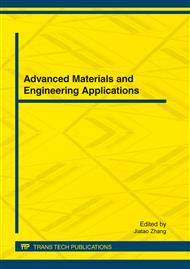p.1
p.6
p.11
p.15
p.21
p.26
p.30
p.37
Influence of Structure and Property of Plasticizers on Viscosity and Aging Process of PVC Plastisols
Abstract:
The molecular structure of DEDB,ATBC,DOTP was simulated by Chemoffice. The viscosity and aging process of PVC plastisols prepared by the three plasticizers were investigated by vibrational viscometer, and the influence of selective interactions between PVC resins and plasticizers on the viscosity and aging process of PVC plastisols were analysed. The results indicate that the viscosity and aging process of PVC plastisols are associated with the number of effective interaction groups of a plasticizer, and the more the number of effective interaction groups a plasticizer has , the higher the viscosity of the plastisols is and the more unstable the plastisols is.
Info:
Periodical:
Pages:
15-20
Citation:
Online since:
March 2012
Authors:
Keywords:
Price:
Сopyright:
© 2012 Trans Tech Publications Ltd. All Rights Reserved
Share:
Citation:


